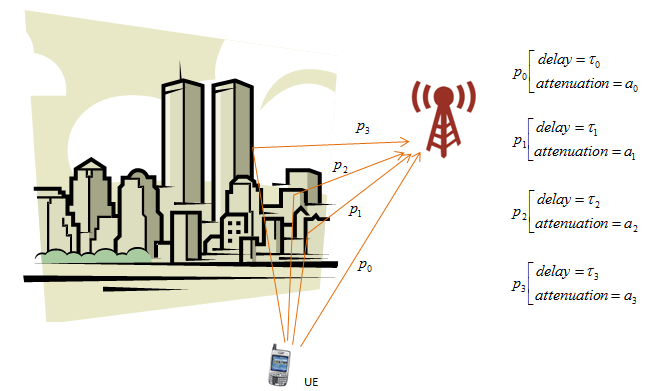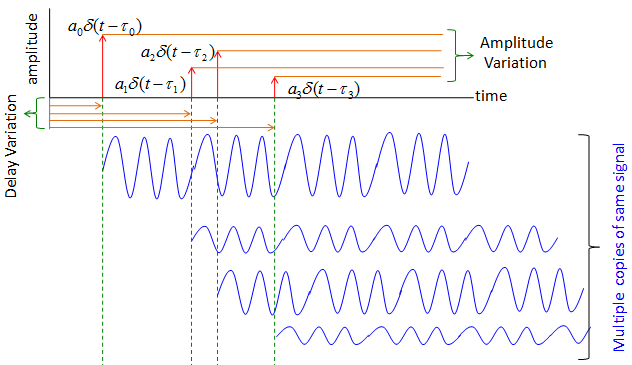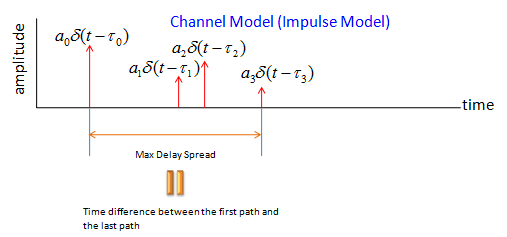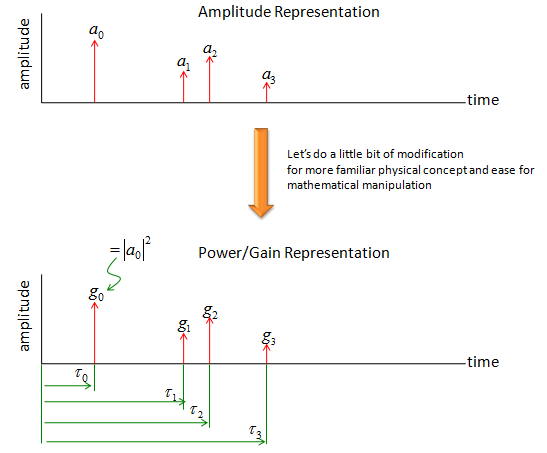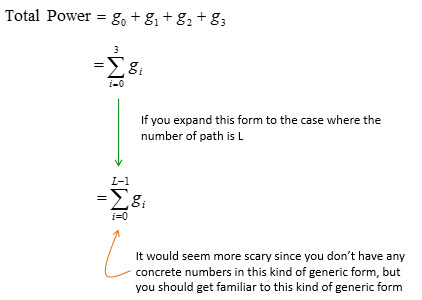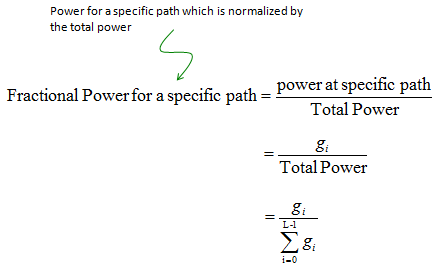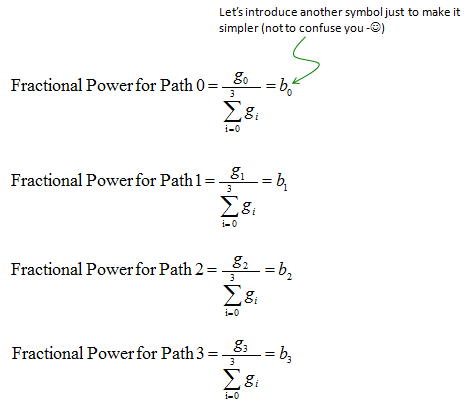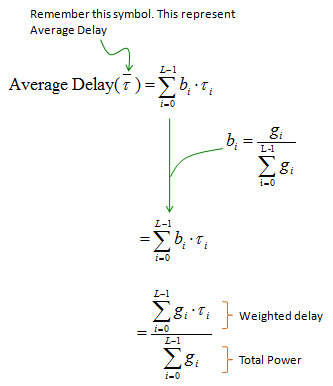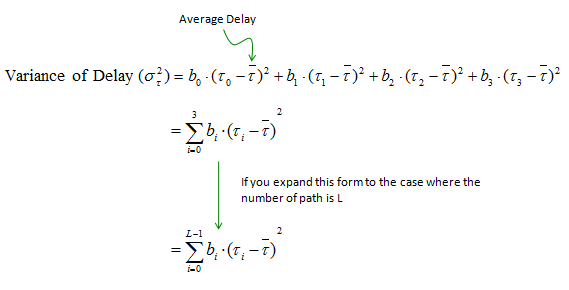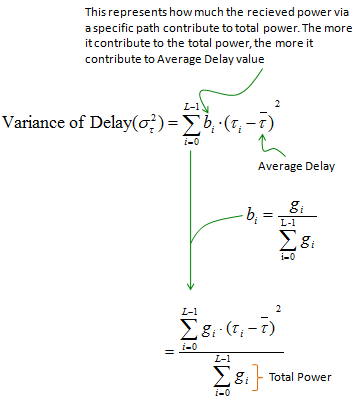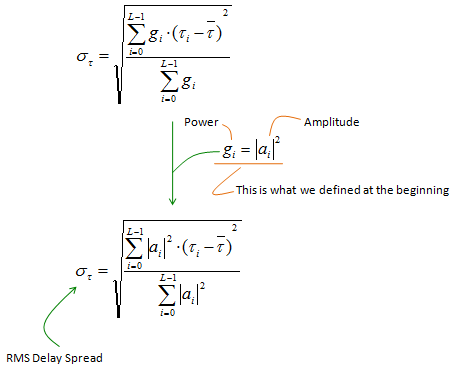|
Communication Technology |
||
|
Delay Spread
Even though a same signal is transmitted from single transmission antenna, the signal may go through various different path. Each of the different path may cause different travel distance if the signal get reflected by one or more obstacles (like buildings) and in some case different path may has different physical property of propagation media, so it is higly likely that the signal traveling through different path would arrive at the reciever antenna at different timing. So if you send a signal from a transmitter antenna and measure the arrival time at the reciever antenna which is a certain distance away from the transmitter antenna, you would get multiple different arrival timing.
If you plot those arrival timing on the axis of time, you would see a certain variation (spread) of those values. This spread is called 'Delay Spread'.
In other words, delay spread refers to the time difference between when the first and last copies of a signal arrive at the receiver when multipath propagation occurs. Multipath propagation is when the signal takes different paths from the transmitter to the receiver, resulting in multiple copies of the signal arriving at different times. The delay spread measures how spread out in time these different signal copies are. A large delay spread means the multiple copies arrive over a longer time period, while a small delay spread means the copies arrive within a shorter time span. So the delay spread gives an indication of the dispersion or spreading of the signal over time caused by taking different paths from transmitter to receiver. The larger the delay spread, the more dispersed the signal is when it arrives.
I think this is enough for the definition for layman. If you want to dig into further details and go through some mathematical model of these delay spread see the following. (I will put description later)
Representation in Channel Impulse Response
The channel impulse response(CIR) shows the output of a communications channel when the input is an impulse or spike. It basically captures the effect of the channel on the signal. In wireless communication, where signals take multiple paths from transmitter to receiver, the CIR provides information about these different multipath components.
The CIR plot has spikes that represent the different paths the signal takes. The timing or position of each spike on the x-axis shows the delay for that path. The height of the spike on the y-axis indicates the amplitude or strength of that path.
So the overall CIR pattern with its spikes spaced out in time shows the response of the wireless channel to an input impulse. The spikes characterize the various multipath components - their timing (delay) and strength (amplitude). This helps understand how the wireless channel impacts the signal based on the different paths taken.
CIR plot the signals detected by a reciever antenna in time vs amplitude plot. it can be represented as follows. As you see here, you will see multiple copies of the same signal coming in with different timing and different amplitue. Using these time variation and amplitude variation, we can defined several different criteria (metrics) to define the nature of the channel. To introduce these criteria (metric) is the main purpose of this page.
The maximum delay spread is a way to quantify the time dispersion or spreading effect of the wireless channel based on the CIR.
To find it from the CIR plot:
Max Delay Spread measures the full time extent over which the multipath arrivals are spread out, from the earliest to the latest component. The wider this spread, the more dispersion in time the channel causes.
The maximum delay spread is useful because it characterizes the full dispersive effect of the channel. Knowing the extent of the delays can help design systems and set requirements to handle the time distortion caused by the wireless channel.
Problems with Max Delay Spread
Max Delay Spread is a very simple in terms of definition and measurement. But it would not be a good metric (indicator) represeing the property of a channel. Issues of Max Delay Spread as a channel property metric is\ illustrated below.
Case 1: This seems to show a typical channel impulse response where the multipath components (arrows) are relatively close together in terms of delay (time axis). The amplitude of these components might vary, but they're clustered within a specific time range.
Case 2: Here, most of the multipath components are clustered similarly to Case 1, but there's an outlier(a4)—a late-arriving component. This outlier significantly extends the max delay spread, even if its amplitude might be low.
Case 3: The multipath components in this case also seem to span a delay range similar to Case 2. However, the amplitudes of these components, especially the late-arriving ones(a4), seem to be different from those in Case 2.
From these cases, we would notice some issues of using Max delay spread as follows. (NOTE : These would not be issues only for Max Delay Spread. It can be an issue of any types of delay spread, but the issues is more profound in Max Delay Spread comparing to other types like average delay spread or RMS Delay spread etc)
Impact of Outliers: Case 1 provides a more "conventional" view of a channel, where the max delay spread might be a reasonably accurate representation of the channel's time dispersion. Case 2 highlights the limitation of using max delay spread as a sole metric. A single outlier can distort the perceived channel property significantly.
Amplitude Variations: Even though Cases 2 and 3 might have a similar max delay spread, their channel characteristics could be quite different due to amplitude variations. This difference can impact system performance in terms of ISI, signal strength, and the effectiveness of mitigation techniques.
To overcome the limitation of the Max Delay Spread (i.e, the distortion by outlier, no consideration of power), a new terms was introduced. It is 'Average Delay Spread' or 'Mean Delay Spread' Just jumping to conclusion, the term 'Average Delay Spread' in reality reprsented by 'Weighted Average Delay Spread' and the term 'Weighted' indicates 'Power Weighted'.
NOTE : Why the 'Power' term is introduced in this definition ? The inclusion of this term is important for several reasons:
Now lets look further into the details of mathematical representation of Average Delay Spread (This note is mainly based on the videos listed under Reference section)
First let's revise a little bit of channel impulse response plot as shown below. There is no changes on time delay part, but definition of amplitude part is changed a little bit. I reprsented the amplitude in the unit of power.
Based on the defintion shown above, total power can be represented as below. This is simple.. just sum of the power of all multipath component. We need this 'Total Power' at the normalization step that comes later.
We can normalize the power of each multipath component with the Total Power as shown below. This normalized power is called as Fractional Power.
Applying this to the specific example channel response plot shown above, we can represent the Fractional Power for each component as follows
Now we can define using the fractional power term and delay term as shown below.
Definition itself is good enough with the equation shown above. But if you want to include fractional power in original form (blown out form), you can rewrite the equation as shown below.
The "Variance of Delay" in a communication system, especially in a multipath environment, quantifies the spread or dispersion of individual path delays around the mean or average delay. It provides an insight into the variability or inconsistency in the delays experienced by signals or packets as they traverse different paths.
The variance of delay quantifies the spread or dispersion of these different delays. A large variance implies a wide spread of delays, while a small variance means the delays are clustered close together.
So in simple terms, variance of delay characterizes how much the different multipath delays deviate from the average delay. It directly impacts the dispersion of the received signal in time domain. A large variance causes more smearing of the signal, while a small variance preserves the signal shape.
Knowing the variance of delay helps determine the type of equalization needed to combat multipath effects in communication systems. It is an important parameter for modeling multipath channels.
NOTE : how variance of delay helps determine the type of equalization ? Equalization techniques are used to combat this dispersion and reconstruct the original signal. The type of equalizer needed depends on the amount of expected delay spread, which is characterized by the variance of delay.
Specifically:
Knowing the variance of delay therefore guides the system designer towards choosing the right equalization strategy for the given multipath conditions.
Mathematical representation of Variance of Delay is as follows. The b0,...,b3 is the weighting factor that are derived in the same way as explained in Average Delay.
If you want to include fractional power in original form (blown out form), you can rewrite the equation as shown below.
RMS delay spread is a metric used to characterize the multipath propagation delay in a wireless channel. It quantifies the amount of delay dispersion experienced by a signal as it propagates through different paths from transmitter to receiver.
Mathematically, RMS delay spread is defined as the square root of the second central moment(i.e, variance or spread around the mean) of the power delay profile.
In simple terms, RMS delay spread is the standard deviation of the different multipath delays, weighted by the power in each path.
A larger RMS delay spread implies the multipath delays are more spread out, causing greater symbol smearing and inter-symbol interference. Smaller values indicate clustered channel taps.
The RMS Delay Spread provides an indication of the multipath richness of the environment and the coherence bandwidth of the channel. A larger RMS Delay Spread indicates a more dispersive channel with a lower coherence bandwidth, which can affect the performance of wireless communication systems.
Reference :
[1] Lecture 20: Max Delay Spread Prof. Aditya K. Jagannatham Dept. of Electrical Engineering
[2] Lecture 21: RMS Delay Spread Prof. Aditya K. Jagannatham Dept. of Electrical Engineering
[3] Lecture 22: Delay Spread and Inter Symbol Interference Prof. Aditya K. Jagannatham Dept. of Electrical Engineering
|
||
